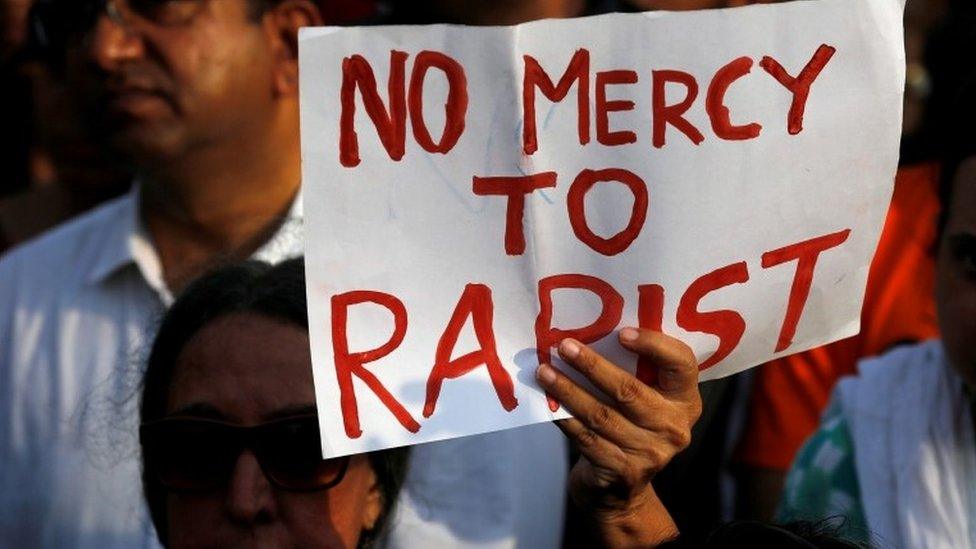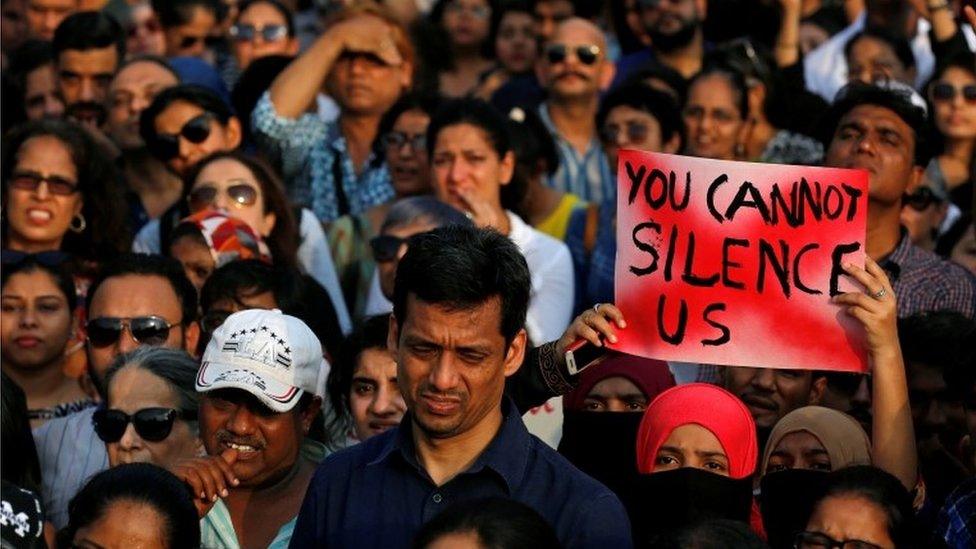Why India's rape crisis shows no signs of abating
- Published

The police in India are looking for the rapists of a girl who has no face, name, home or number.
She was possibly between nine and 11 years old, and her mutilated corpse was found in a bush recently near a playground in western Gujarat state's bustling Surat city, known the world over for its diamond polishing industry. Her battered body bore 86 injury marks. The autopsy surgeon believes that the injuries "seem to have been caused over a period ranging from one week to a day prior to the recovery of the body".
The police believe she was held captive, tortured and ravaged. More than 10 days after they found her body, they are clueless about her identity: they have trawled the list of some 8,000 missing children in the state and come up with nothing. "There was no sign of struggle at the spot where the body was found," the local police chief says.
Putting up a struggle seems to be futile when rape is increasingly used as an instrument to assert power and intimidate the powerless in India. This is not surprising, many believe, in a hierarchical, patriarchal and increasingly polarised society, where hate is being used to divide people and harvest votes.
An awful sex ratio imbalance - largely because of illegal sex-selection abortions - means it is a country full of men. The country sees 112 boys born for every 100 girls, which is against the natural sex ratio of 105 boys for every 100 girls. A preference for boys has meant that more than 63 million women are statistically "missing". Many believe such skewed ratios can contribute to increased crimes against women.

The northern state of Haryana, which records the highest number of gang rapes in India, has the worst sex ratio in the country. In January alone, a 50-year-old man was held for mutilating a 10-year-old girl, a 15-year-old boy allegedly raped a three-and-a-half-year-old girl, a 20-year-old married women was raped by two men, a 24-year-old man was held for kidnapping and abducting a student and a minor's girl's brutalised body was found in the fields. And these were only the reported cases.
In Indian-administered Kashmir, a poisonous cocktail of biology and bigotry led to the macabre rape and murder of an eight-year-old Muslim nomadic girl in January. She was kidnapped, kept captive in a Hindu temple, raped repeatedly and dumped in a forest. It was a warning to the minority Muslim nomads in the area to stop grazing their animals on Hindu owned land, in a restive part of the region, which is simmering with religious tensions.
Eight Hindu men have been charged with the Kashmir gang-rape and murder. Their trial began in a fast track court on Monday. Two ministers from the ruling Hindu nationalist BJP who openly attended a rally in support of the accused resigned after the rising outrage forced the party's hand and compelled Prime Minister Narendra Modi to condemn the incident - on Twitter.
In the southern state of Kerala, a bank manager declared on his Facebook wall that it was "good" that the nomad girl was killed, because "she would have come as a [human] bomb against India tomorrow". His employers sacked him.
Mr Modi has tweeted that India's "daughters will get justice". His assurances, many believe, have begun to ring hollow. (Lawmakers belonging to his own party are being accused of rape, and supporting men accused of rape, and action is only taken against them only after widespread condemnation of their behaviour.)
Other politicians haven't done much better. When three men were convicted in 2014 for the gang rape of a journalist, Mulayam Singh Yadav, leader of the regional Samajwadi Party said: "Boys make mistakes. They should not hang for this. We will change the anti-rape laws."

Indian women have to reconcile themselves with the reality: you save yourself - dress up properly, don't go out unescorted or simply stay at home - or remain unsaved.
What is disturbing is what appears to be the rising number of children who are being targeted. India's crime records show that reported rapes of minor children had more than doubled between 2012 and 2016.
More than 40% of the country's female victims were minor children. The uptick could, however, have something to do with increased and better reporting by the police and media, and widening the definition of rape after the horrific 2012 gang-rape and murder of a 23-year-old student in Delhi.
'Legitimising rape'
India is not alone when it comes to high rates of incidence of rape. But many believe patriarchy and a skewed sex ratio may be making matters worse. There is public apathy as well: the rights and security of women never become election issues.
Rape can also be ingrained and justified in cultures. When Goths attacked Rome in 410 AD St Augustine called wartime rape an "ancient and customary evil". An ancient Indian treatise, according to American Indologist Wendy Doniger, "legitimised rape as a form of marriage and gave some degree of legal sanction, retroactively, to women who had been raped".
So has nothing much changed after the 2012 Delhi gang rape sparked global outrage and violent public protests?
It is difficult to say. The good news is that there is higher and better reporting of rape. The bad news is that a shambolic criminal justice system remains vulnerable to political pressures and allows many of the accused to go scot free - only one in four cases of rape in India end in conviction.
Also many Indians - men and women - refuse to believe that sexual violence is a serious problem eating away at India's vitals. And most political parties, including Mr Modi's BJP, don't appear to recognise and treat it as the crippling societal crisis it is.